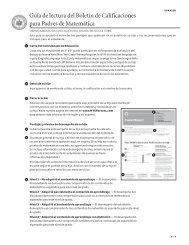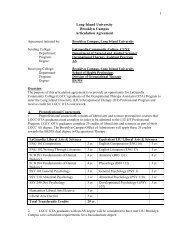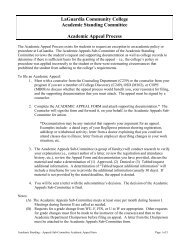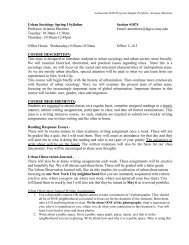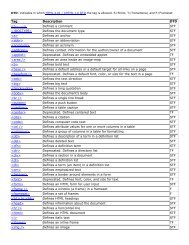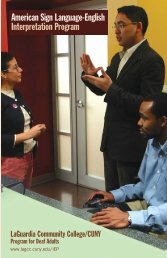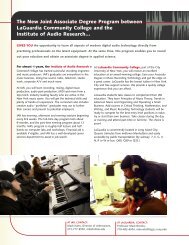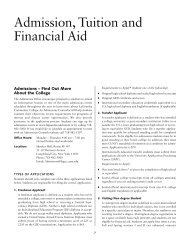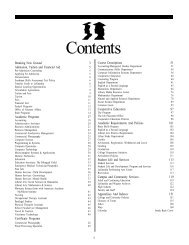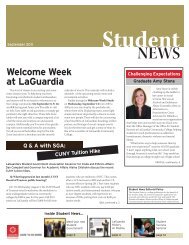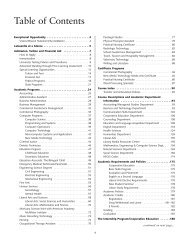Download - LaGuardia Community College
Download - LaGuardia Community College
Download - LaGuardia Community College
Create successful ePaper yourself
Turn your PDF publications into a flip-book with our unique Google optimized e-Paper software.
<strong>Community</strong> Health Workers: HistoricalReviewDonald E. Proulx, M.Ed.Associate Director of the ArizonaArea Health Education Centers (AHEC) ProgramCo-Director of the <strong>Community</strong> Health WorkerNational Education Collaborative (CHW-NEC)University of ArizonaTucson, ArizonaFriday, June 10,2011CHW Conference<strong>LaGuardia</strong> <strong>Community</strong> <strong>College</strong>
<strong>Community</strong> Health Workers in the U.S.o In many cultures, traditional healing systemsdeveloped before Western medicine…many formsgrew in the U.S.o The American Indian community “medicine men”o Latino Communities…”curanderos”…naturalhealers/medicine meno Natural “lay aids” (Promotores grew to be verypopular in U.S.-Mexico border neighborhoods, butthey are found today throughout the country…awide migration of Hispanics
o History in the U.S.o 1950s: saw the first volunteer and paid CHW programso Started in Native Nations in the west and in migrant farm workercamps in the southwesto Indian Health Service (1960s) community health representatives(CHRs)o 1960s and 1970s growth of community health centers(CHCs) with outreach staff.o 1970s referred to as “lay health advisors” (no longer called “lay”workers for the most part nationally today)o 1980s the Federal “Healthy Start” Program and RuralHealth Outreach Grants (HRSA) employed CHWso 1980s motivated by the AIDS epidemic…investments incommunity health outreach programs (founded 1987 the AIDSCoalition to Unleash Power (ACTUP)
History in the U.S.o With the HIV/AIDS epidemic came the creation of new public healthintervention programso Local health departments and community-based organizations (CHCsand others) began to hire CHWs to conduct outreach, provide clientcenterededucation, community education, facilitate support groups,make home and hospital visits…influenced the development of theCHW field in the U.S.o 1990s saw job creation with Welfare Reform…CHWs now getting jobsin what they had been doing as neighborhood volunteers.o 1990s and 2000s witnessed more people learning about the serviceof CHWs; workforce studies, professional articles, and reports aboutCHWs became common; local, state, and national networks andconferences, and trainings began to bring CHWs together (Rosenthal,2009). Particularly the APHA SPIG for CHWs.o Through 1990s researchers conducted regional and national studies
History in the U.S.o The National <strong>Community</strong> Health Advisor Study, 1994-1998(Rosenthal, 1998), was a “participatory research project” atThe University of Arizona, funded by the Annie E. CaseyFoundation. The study is available from the foundation at 701St. Paul Street, Baltimore, MD 21202; (410) 223-2890.o This study elucidated “core roles and competencies” ofCHWs; it also identified the many community and clinicsettings where CHWs work.o In 1995 a commentary entitled “<strong>Community</strong> Health Workers:Integral Members of the Health Care Work Force” appeared inthe American Journal of Public Health (Witmer, Seifert,Finocchio, Leslie, and O’Neil, 1995).o The Institute of Medicine’s “Unequal Treatment: ConfrontingRacial and Ethnic Disparities in Health Care” pointed to theimportance of CHWs in reducing health inequalities (Smedley,Stith, and Nelson, 2002).
CHW Definition and Core Roleso The definition of community health workers has evolved sincethe 1970s, and several studies have particularly focused on roledefinitions, education or training, scope of practice responsibilities,and validation of competence.o The APHA SPIG (now CHW Section) submitted the followingdescription of the CHW field to the U.S. Dept. of Labor in 2007:“A community health worker (CHW) is a frontline public healthworker who is a trusted member of and/or has an unusually closeunderstanding of the community served. This trusting relationshipenables the CHW to serve as a liaison/link/intermediary betweenhealth and social services and the community to facilitate access toservices and improve the quality and cultural competence of servicedelivery. A CHW also builds individual and community capacity byincreasing health knowledge and self-sufficiency through a range ofactivities such as outreach, community education, informalcounseling, social support and advocacy.”o In January, in the Federal Register Vol. 74(12) the U.S. OMBpublished the 2010 revisions to the Standard OccupationalClassification (SOC) giving a unique occupational classification for“community health workers (SOC 21-1094).
CHW Definition and Core RolesooooThe National <strong>Community</strong> Health Advisor (CHA) Study (Rosenthal andadvisors/contributors, 1998) is the first examination nationally of “whoCHWs are, how they are defined, and what core roles and responsibilitiesare delineated by CHWs, themselves, and by CHW health and humanservices programs.”The Rosenthal study was highly participatory with a 36-member advisorycouncil composed primarily of CHAs, who were representative of CHAnetworks and programs throughout the U.S.; the council also included CHAprogram supervisors (non-CHAs as such) and CHA advocates from thepublic and private sector. The term <strong>Community</strong> Health Advisor (CHA) wasused at this time (1994-98) as the generic for CHWs (today’s generic termnationally).The council role was to refine the study agenda, interpret data gathered,and develop recommendations (the precepts of CBPR).Study issue Areas were:(1) CHA core roles and competencies(2) Evaluation strategies for CHA programs(3) CHA career and field advancement(4) The role of CHAs in the changing health system
Education and CompetenceThe core roles and competencies identified by theNational CHA Study7 Roles:1) Cultural mediation between communities and health2) Informal counseling and social support3) Providing culturally appropriate education4) Advocating for individual and community needs5) Assuring people get the services they need6) Building individual and community capacity7) Providing direct services8 Skill Competencies7 Quality Competencies
Education and Competence8 Skill Competencies(1) Communication skills(2) Knowledge based skills(3) Capacity building(4) Interpersonal skills(5) Service coordination skills(6) Teaching skills(7) Advocacy skills(8) Organizational skills7 Quality Competencies(1) <strong>Community</strong> relationship(2) Desire to help(3) Empathy(4) Persistence(5) Creativity andResourcefulness(6) Personal strength & courage(7) Respectfulness
Curriculum DevelopmentsooooIn 1986 The Arizona Area Health Education Center Program in the RuralHealth Office of The University of Arizona developed a “Prenatal HealthCourse titled “Un Comienzo Sano” (A healthy beginning) Joel Meister andJill de Zapien, as PIs. This was originated as a training for migrant farmworker promotores in response to their perinatal health needs in the Yuma,Arizona and San Luis, Sonora, Mexico border region. This curriculum wasadopted by the Arizona Department of Health Services for the state HealthStart program. (Dr. Ortiz talked about the short handled hoe)A shift was seen for developing curricula of entry-level common (“core”)skills and competencies in the mid 1990s.By 1995, college-based credit and non-credit curricula began to appear.The “<strong>Community</strong> Health Works” project was funded by the U.S. Departmentof Education’s Fund for the Improvement of Postsecondary Education(FIPSE) program to establish a college credit-bearing curriculum for CHWs;this project was carried out by San Francisco State University and City<strong>College</strong> (1995-1998), and a 17 credit performance-based basic certificateprogram emerged which was employer advised and accepted…they evendeveloped a career ladder of employment advancement for CHWs in theBerkley California region: CHW I (basic), CHW II (intermediate), and CHWIII (management/supervisory level).
Curriculum Developmentso Then came another FIPSE-funded rural community collegecurricular development project in 1998 titled: “Project JumpStart.” The Principal Investigator was Don Proulx, AssociateDirector of the Arizona Area Health Education CenterProgram. This project engaged 4 community colleges and 3regional AHECs. A guidebook for college-related programswas published: ”Core Curriculum Guidebook for a <strong>Community</strong>Health Worker Basic Certificate Program” (Proulx andcontributors, 2002) This instructional guide contained 6 corecompetency modules and a fieldwork course guide.o A second FIPSE funded project was carried out by TheUniversity of Arizona AHEC Program, with Don Proulx as PIand with co-director E. Lee Rosenthal. This was a nationalproject titled “A National <strong>Community</strong> of Practice forPostsecondary <strong>Community</strong> Health Worker Education” (2004-2008). It became known as the <strong>Community</strong> Health WorkerNational Education Collaborative (CHW-NEC) www.chwnec.org
A National <strong>Community</strong> of Practiceo The CHW-NEC project was designed to offer the most promisingpractices from lessons learned across the country for the entry-levelcore competency-based development of community health workers.o The project continues today as a nationally-based participatoryresearch and dissemination model. It followed the precepts of theCBPR model.o Recommendations of this project are published as KeyConsiderations for Opening Doors: Developing <strong>Community</strong> HealthWorker Education Programs. Proulx, DE, Rosenthal,EL, andcontributors, The University of Arizona AHEC Program (2008). Thispublication is available and can be downloaded from the projectwebsite www.chw-nec.orgo Technical Assistance Workshops (6) were provided across the U.S.over the funded life of the project (2004-2008), and these events arecaptured on DVDs. Workshop related educational materials andPowerPoint presentations used in these TA events are available onthe project website.
Credentialing CHWsooTexas: The Texas legislature (2001) mandated all promotores or CHWswho receive compensation for their services be certified…and trainingprograms needed to be state approved and must use a standardizedcurriculum in 8 core areas of competence: advocacy, interpersonalrelations, capacity building, communication, knowledge, organization,teaching, and service coordination (right out of the CHA National Study—Rosenthal et al.) The Texas Dept. of Health administers the program. (SeeCDC, Preventing Chronic Disease: Special Issue, November 2005:05_0059) http://www.cdc.gov/pcd/issues/2005/nov/05_0059.htmOhio (2003) adopted a certification which is regulated by the state Board ofNursingo Minnesota passed de facto certification for Medicaid reimbursement (2008)CHW must be under medical supervision, must complete standardtraining, CHW services for patients in “self-management educationand training”…cannot bill state directly; employers bill state.ooLimited certification programs in Indians and Alaska; two states with majorstate-funded programs, KY and NM, do not have credentialingThere are CHW credentialing bills being introduced in CA,MA, NM, OR,PA…and in TX there are two new bills HB 2610 (navigators) and 2244updating state certification.
Credentialingo Some Cautions:o Credentialing can be a “two-headed” phenomena:o “right-headed” is to develop credentialing that is well informed byveteran CHWs to assure employers of competent hires and toprotect the public interest in quality and competent service.o “wrong-headed” is to let credentialing systems disenfranchise ourseasoned and competent CHWs in the process…we must offeralternative means of validating competence…make use ofgrandfathering measures.o Also, don’t let college-based education change the very nature andneighborhood quality of CHWs…Mark Homan of Pima <strong>Community</strong><strong>College</strong>, retired Director of the CHW Program there, said somethingto the effect: “…we can teach CHW students to be good at college,but can we teach them to be good at community?” We must!
Some Cautionso CHWs need to know their limits and know how to refer asappropriate to credentialed primary care providers…to help peoplefind a “medical home” to improve access to continuity of care.o They need to be trained to provide evidence-based healthinformation…do no harm! Remember my cautions regardingcredentialing for CHWs.o They need to know how to blend traditional ways with Westernmedicine so as not to disrespect a person’s culture. This is usuallyan enculturated competence for CHWs who are themselvesindigenous and already respected and trusted by the residents oftheir own neighborhoods.o <strong>Community</strong>-based public health interventions should invite CHWsupport…the personification of culturally appropriate public health.The CHW is the entre to neighborhoods where public health andhealth professions education and health prevention and promotioninterventions can occur with the full participation of the residents,leaders, and institutions already working within theseneighborhoods. CBPR.
Closing Remarks<strong>Community</strong> Health Workers As Change AgentsIf there is one thing that CHWs do well in terms of “community” it is“advocacy” in, for, and with people for public policy change andsystems change that promote and provide “equal access” to theresources and opportunities essential for human health. These includeadequate schools, quality education, basic clean housing, jobs payinga decent wage, nutrition, clean water and proper sanitation, safety inneighborhoods, access to health care and human services, civilliberties, religious freedom, a political voice, and the like…all thethings that any citizen can expect to enjoy in the United States.When we (as CHWs) examine the needs of “segregated” people in our“disadvantaged” and “disenfranchised’ neighborhoods…look first atthe picture seen there with respect to our cultural richness, humanvalues, and survival assets, then go about the hard work of gettingpolicy-makers, educators, health care service and human servicesystems with culturally competent health professionals and ourselvesto intervene as part of the social justice picture for the humancondition in the U.S.



